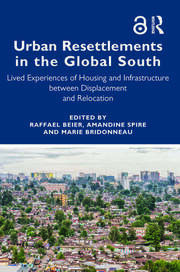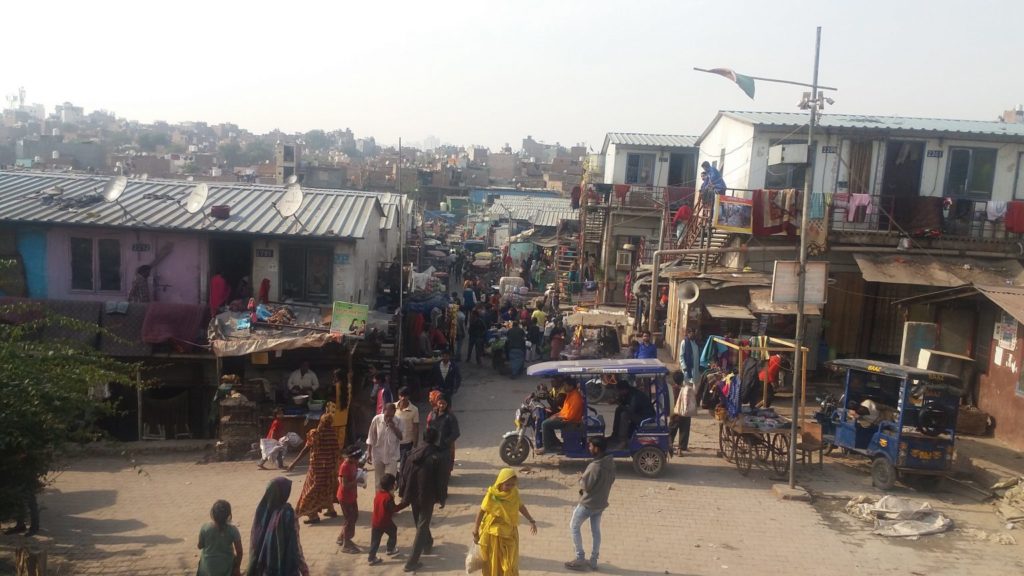Beier, Raffael, Amandine Spire, and Marie Bridonneau, eds. Urban Resettlements in the Global South: Lived Experiences of Housing and Infrastructure Between Displacement and Relocation. Routledge, 2021.

Urban Resettlements in the Global South is an engaging book, as it gives a unique urban perspective to resettlement and applies this view to ten different case studies in various countries, from India to Morocco to Mozambique. In the introduction, the authors indicate that this book aims to analyze displacement, relocation, and reinstallation together, as this is what they believe “urban resettlement” entails. The book also discusses governance and spatial reordering, experiences of change, long-term perspectives, and looking at displacement through the lens of COVID-19. Each of the four main sections encompasses two to three chapters that focus on specific case studies. The last section of the book touches on the implications of the recent COVID-19 pandemic and how the pandemic has caused displacement in many places, such as South Africa.
The case study of Kathputli Colony Rehabilitation Project in Delhi, India was particularly interesting. In the 2000s, a resettlement project moved slum dwellers to alternative locations, causing them to be negatively affected in various aspects of their lives. Although Delhi recently created an alternative strategy plan, these relocation projects will still have many negative repercussions, as the slum redevelopment means that residents must dismantle their current homes and relocate to transit camps, while rehousing is being built. These rehousing complexes, built by the developer, only allow the eligible displaced families to obtain a flat in the newly built area, meaning not everyone who was uprooted from their homes would be able to access new housing, leaving many in a vulnerable state.

These transit camps are what really caught my attention, as this temporary resettlement situation has numerous effects on the displaced families’ lives and is often compared to refugee camps by the inhabitants. Many of these slum families must wait in these transit camps for decades before moving into their final destinations, which completely defeats the purpose of these camps as “temporary resettlement”. The authors of this chapter focus on how these camps are used by the developer to control and take advantage of this vulnerable population. I was not shocked by how the developer manipulated and intimidated the families into moving into the camps; however, what I was surprised about was how there were three evacuation groups, and each group was treated completely differently by the developer in this case. I was confused as to why the first group was given free meals, free transportation, and monetary help when they moved in, while the other groups did not receive any help at all. The book is not clear on the reasons for such unequal treatment.
Transit camps used various tactics to control their inhabitants and the living conditions were actually worse in these camps than in the slums. The residents spoke about how they often had power cuts, no water, and poorly maintained public toilets, which was ironic because this was supposed to be a better living situation than the slums; however, it was as if they moved from one slum to another. When residents would ask questions as to why they did not have adequate services or why things were extremely unsanitary, they would simply have their electricity cut off or would lose access to public toilets as punishment. It was unfortunate to read how so many of these residents felt as though they were not treated as human beings, but they could not do anything to change that. They had moved from ad hoc and stigmatized “slums” to privatized, legitimated “camps” but despite these changing labels and idealization of the camps as “temporary”, the real conditions did not improve.
After reading this book of numerous case studies in the Global South, I would be interested in seeing if and how these processes affect individuals in North America or OECD countries. I am curious to know how the dynamics between developers and residents who are being resettled is different in the Global North because of the perception of better development standards in high-income countries?
- Imaan Somji
